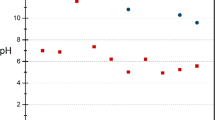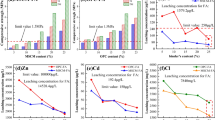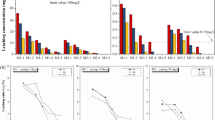Abstract
The coal-fired power industry faces pressing needs to improve disposal practices for the generated flue gas desulfurization (FGD) wastewater and coal fly ash (CFA). Zero-liquid-discharge (ZLD) strategies are gaining significant interest and can be achieved by co-disposing the concentrated FGD wastewater brine with CFA and Portland cement in a solidification/stabilization (S/S) process—a novel strategy that manages two wastes simultaneously. In this study, the stability of such S/S solids produced by utilizing bituminous CFA was evaluated for the mass transport release of major components (Ca2+, Cl−, Mg2+, Na+, and SO42−) and heavy metal oxyanions (As, Cr, and Se) in long-term leaching tests. Particularly, the impact of FeSO4 (FS) addition to the S/S mixture for the purpose of enhancing heavy metal immobilization was assessed. Results showed that FS addition to the S/S process decreased the solid’s cumulative release and flux at shorter leaching times for the major components Ca2+, Cl−, Mg2+, Na+, and SO42−, but this effect was diminished over time. However, FS addition significantly decreased release of oxyanions As, Cr, and Se throughout the prolonged leaching time, indicating that FS addition could increase the likelihood of successful long-term disposal of S/S solids of concentrated FGD brines containing these heavy metal oxyanions. Results of this study can help the power industry to further assess and optimize the co-disposal ZLD strategy to minimize environmental risks.







Similar content being viewed by others
References
ACAA (2013) 2013 coal combustion product (CCP) production & use survey report. Association, American Coal Ash
Batchelor B (2006) Overview of waste stabilization with cement. Waste Management 26:689–698
Baur I, Johnson CA (2003) Sorption of selenite and selenate to cement minerals. Environ Sci Technol 37(15):3442–3447
Bothe JV Jr, Brown PW (1999) The stabilities of calcium arsenates at 23±1°C. J Hazard Mater 69(2):197–207
Choi W-H, Lee S-R, Park J-K (2009) Cement based solidification/stabilization of arsenic-contaminated mine tailings. Waste Management 29:1766–1771
Chrysochoou M, Dermatas D, Meng X (2006) Evaluation of ettringite and hydrocalumite formation for heavy metal immobilization: literature review and experimental study. J Hazard Mater 136(1):20–33
Cornelis G, Johnson CA, Gerven TV, Vandecasteele C (2008) Leaching mechanisms of oxyanionic metalloid and metal species in alkaline solid wastes: a review. Appl Geochem 23(5):955–976
De Windt L, Badreddine R (2007) Modelling of long-term dynamic leaching tests applied to solidified/stabilised waste. Waste Management 27(11):1638–1647
Dermatas D, Meng X (2003) Utilization of fly ash for stabilization/solidification of heavy metal contaminated soils. Engineering Geology 70(3–4):377–394
Dixit S, Hering JG (2003) Comparison of arsenic(V) and arsenic(III) sorption onto iron oxide minerals: implications for arsenic mobility. Environ Sci Technol 37(18):4182–4189
Garrabrants AC, Kosson DS, DeLapp R, Kariher P, Seignette PFAB, van der Sloot HA, Stefanski L, Baldwin M (2012) Interlaboratory validation of the leaching environmental assessment framework (leaf) method 1314 and method 1315, United States Environmental Protection Agency.
Garrabrants AC, Kosson DS, DeLapp R, van der Sloot HA (2014) Effect of coal combustion fly ash use in concrete on the mass transport release of constituents of potential concern. Chemosphere 103:131–139
Glasser FP (1997) Fundamental aspects of cement solidification and stabilisation. J Hazard Mater 52(2–3):151–170
Goodarzi F, Huggins FE (2001) Monitoring the species of arsenic, chromium and nickel in milled coal, bottom ash and fly ash from a pulverized coal-fired power plant in western canada. J Environ Monitor 3(1):1–6
Goodarzi F, Huggins FE, Sanei H (2008) Assessment of elements, speciation of As, Cr, Ni and emitted Hg for a Canadian power plant burning bituminous coal. International Journal of Coal Geology 74(1):1–12
Huffman GP, Huggins FE, Shah N, Zhao J (1994) Trace element transformations in coal-fired power systems speciation of arsenic and chromium in coal and combustion ash by XAFS spectroscopy. Fuel Processing Technology 39(1):47–62
Huggins FE, Senior CL, Chu P, Ladwig K, Huffman GP (2007) Selenium and arsenic speciation in fly ash from full-scale coal-burning utility plants. Environ Sci Technol 41(9):3284–3289
Izquierdo M, Querol X (2012) Leaching behavior of elements from coal combustion fly ash: an overview. International Journal of Coal Geology 94(0):54-66.
Kameswari KSB, Bhole AG, Paramasivam R (2001) Evaluation of solidification/stabilization (S/S) process for the disposal of arsenic-bearing sludges in landfill sites. Environ Eng Sci 18:167–176
Keller IRB (2002) The immobilisation of heavy metals and metalloids in cement stabilised wastes: a study focusing on the selenium oxyanions SeO32- and SeO42-, Swiss Federal Institute of Technology. Zurich, Switzerland
Kosson D, van der Sloot H, Garrabrants A, Seignette P (2014) Leaching test relationships, laboratory-to-field comparisons and recommendations for leaching evaluation using the leaching environmental assessment framework (leaf). EPA-600/r-14/061, United States Environmental Protection Agency.
Miller J, Akhter H, Cartledge FK, McLearn M (2000) Treatment of arsenic-contaminated soils. II: treatability study and remediation. J Environ Eng 126:1004–1012
Moon DH, Waznea M, Yoon I, Grubba DG (2008) Assessment of cement kiln dust (CKD) for stabilization/solidification (s/s) of arsenic contaminated soils. J Hazard Mater 159:512–518
Narukawa T, Takatsu A, Chiba K, Riley KW, French DH (2005) Investigation on chemical species of arsenic, selenium and antimony in fly ash from coal fuel thermal power stations. J Environ Monitor 7(12):1342–1348
Nishimura T, Robins RG (1998) A re-evaluation of the solubility and stability regions of calcium arsenites and calcium arsenates in aqueous solution at 25°C. Miner. Process. Extr. Metall. Rev. 18(3-4):283–308
Palfy P, Vircikova E, Molnar L (1999) Processing of arsenic waste by precipitation and solidification. Waste Management 19:55–59
Qian G, Cao Y, Chui P, Tay J (2006) Utilization of mswi fly ash for stabilization/solidification of industrial waste sludge. J Hazard Mater B129:274–281
Ramgobeen D (2010) “Preparation and testing of chloride & sulphate containing minerals from industrial wastes”, solidification/stabilisation of chloride & sulphate ions from apc residues with calcium aluminate cements. University College of London, London, England
Renew JE, Huang C-H, Burns SE, Carrasquillo M, Sun W, Ellison KM (2016) Immobilization of heavy metals by solidification/stabilization of co-disposed flue gas desulfurization brine and coal fly ash. Energy & Fuels 30:5042–5051
Renew JE, Huang C-H, Kosson DS (2017) Mass transport release of heavy metal oxyanions from solidified/stabilized co-disposed flue gas desulfurization brine and coal fly ash monoliths. 2017 World of Coal Ash (WOCA) Conference in Lexington, KY.
Richard FC, Bourg ACM (1991) Aqueous geochemistry of chromium: a review. Water Res 25(7):807–816
Roy WR, Berger PM (2011) Geochemical controls of coal fly ash leachate pH. Coal Combustion and Gasification Products 3:63–66
Séby F, Potin-Gautier M, Giffaut E, Borge G, Donard OFX (2001) A critical review of thermodynamic data for selenium species at 25°C. Chemical Geology 171(3–4):173–194
Singh TS, K. K. Pant (2006) Solidification/stabilization of arsenic containing solid wastes using Portland cement, fly ash and polymeric materials. J Hazard Mater B131:29–36.
Su C, Ludwig RD (2005) Treatment of hexavalent chromium in chromite ore processing solid waste using a mixed reductant solution of ferrous sulfate and sodium dithionite. Environ Sci Technol 39:6208–6216
Sun W, Renew JE, Zhang W, Tang Y, Huang C-H (2017) Sorption of Se(IV) and Se(VI) to coal fly ash/cement composite: effect of Ca2+ and high ionic strength. Chemical Geology 464:76–83
USEIA (2015) Coal explained - coal prices and outlook. Energy Information Administration, U.S.
USEPA (1992) Method 1311 - toxicity characteristic leaching procedure. USEPA.
USEPA (1993) Method 300.0 determination of inorganic anions by ion chromatography, USEPA.
USEPA (1994a) Method 200.8 - determination of trace elements in waters and wastes by inductively coupled plasma - mass spectrometry, USEPA.
USEPA (1994b) Sample preparation procedure for spectrochemical determination of total recoverable elements. USEPA.
USEPA (1996) Method 3052 - microwave assisted acid digestion of siliceous and organically based matrices, USEPA.
USEPA (2007) Method 6020a - inductively coupled plasma mass spectrometry, USEPA.
USEPA (2009) Steam electric power generation point source category: final detailed study report. USEPA (ed), Washington, DC.
USEPA (2010) Background information for the leaching environmental assessment framework (leaf) test methods. EPA/600/r-10/170.
USEPA (2012) Method 1313 - liquid-solid partitioning as a function of extract pH using a parallel batch extraction procedure. USEPA.
USEPA (2013) Method 1315 - mass transfer rates of constituents in monolithic or compacted granular materials using a semi-dynamic tank leaching procedure, USEPA.
USEPA (2015) Effluent limitations guidelines and standards for the steam electric power generating point source category; final rule Agency, U.S.E.P. (ed), Federal Register.
Wang S, Vipulanandan C (2000) Solidification/stabilization of Cr(VI) with cement leachability and xrd analyses. Cement Concrete Res. (30):385-389.
Wang T, Wang J, Tang Y, Shi H, Ladwig K (2009) Leaching characteristics of arsenic and selenium from coal fly ash: Role of calcium. Energy & Fuel 23(6):2959–2966
Zhang W, Oswal H, Renew J, Gallagher B, Ellison K, Huang C-H (2019) Solidification/stabilization of flue-gas-desulfurization brine and coal fly ash for heavy metals and chloride immobilization: effects of S/S conditions and zero-valent iron pretreatment. J Hazard Mater 384(15):121463
Acknowledgements
The authors thank Drs. David Kosson and Kevin Brown of Vanderbilt University for comments on this work.
Availability of data and material
All the data and material pertinent to this manuscript are included and have been reviewed by all authors.
Funding
This work was supported by the Environmental Research and Education Foundation. J. Renew and W. Zhang thank partial support from the Georgia Power Fellowship.
Author information
Authors and Affiliations
Contributions
J. Renew contributed to the majority of data generation and manuscript draft preparation, W. Zhang contributed to data revaluation and manuscript writing, and C.-H. Huang supervised this work and contributed to data evaluation and manuscript writing.
Corresponding author
Ethics declarations
Ethics approval and consent to participate
All authors provide ethics approval and consent to participate in this manuscript.
Consent for publication
All authors consent to publish this manuscript.
Competing interests
The authors declare no competing interests.
Additional information
Responsible Editor: Philippe Garrigues
Publisher’s note
Springer Nature remains neutral with regard to jurisdictional claims in published maps and institutional affiliations.
Supplementary information
ESM 1
(PDF 240 kb)
Rights and permissions
About this article
Cite this article
Renew, J.E., Zhang, W. & Huang, CH. Mass transport release of heavy metal oxyanions from solidified/stabilized co-disposed flue gas desulfurization brine and coal fly ash monoliths. Environ Sci Pollut Res 28, 29945–29957 (2021). https://doi.org/10.1007/s11356-021-12778-0
Received:
Accepted:
Published:
Issue Date:
DOI: https://doi.org/10.1007/s11356-021-12778-0




